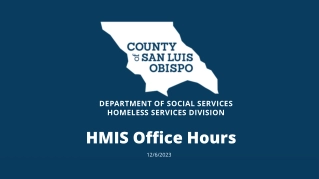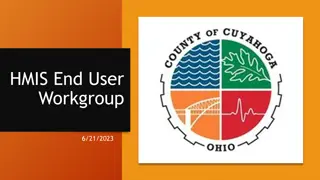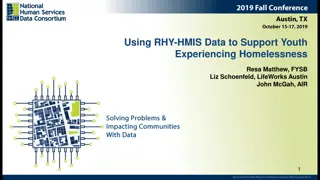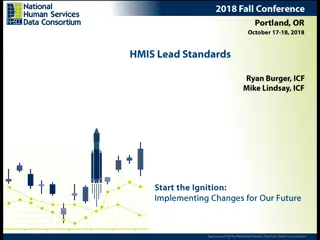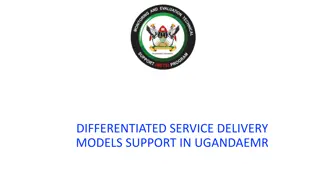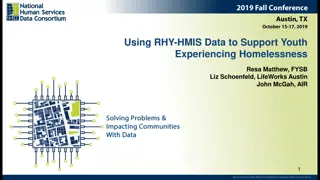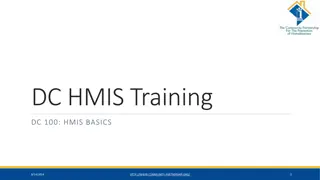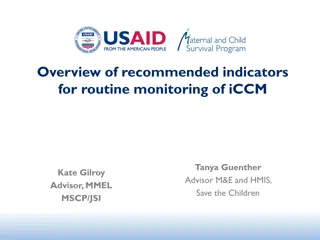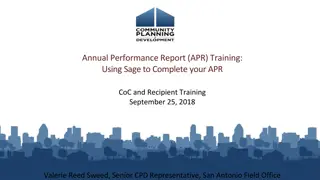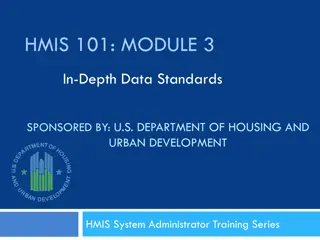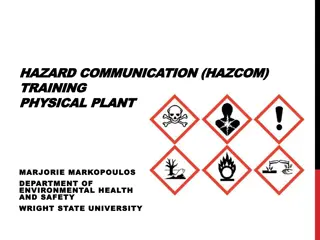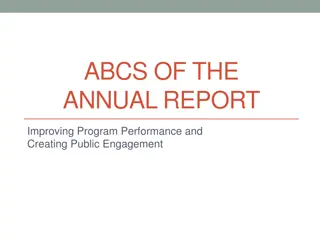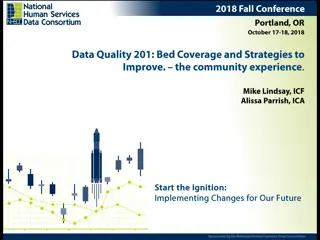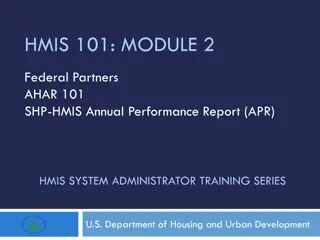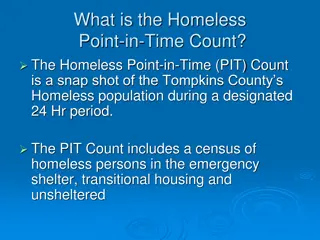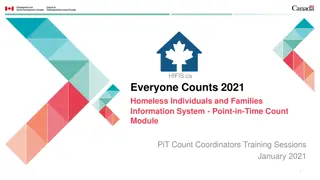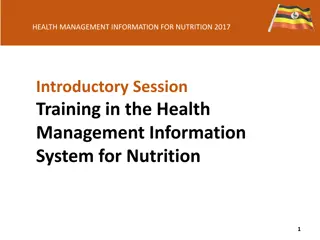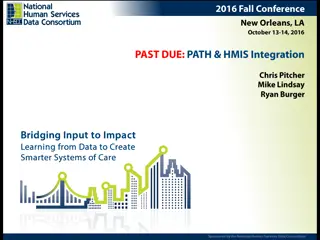DEPARTMENT OF SOCIAL SERVICES HOMELESS SERVICES DIVISION. HMIS Office Hours
Reviewing and correcting data quality issues in the Department of Social Services Homeless Services Division, focusing on inaccurate homeless history, services outside of enrollments, and their impacts on migration workflows and system performance. The team, led by project managers and system analys
2 views • 12 slides
HMIS End User Workgroup Discussion Overview
This post provides key details about the HMIS End User Workgroup meeting held on 6/21/2023. It covers the introduction of committee members, discussions on HMIS data standards, communication strategies, and important resources for end users. The workgroup's vision, purpose, and upcoming changes in t
5 views • 27 slides
Supporting Youth Experiencing Homelessness Through RHY-HMIS Data
Utilizing RHY-HMIS data to aid youth facing homelessness is crucial. The Runaway and Homeless Youth Program emphasizes trauma-informed, age-appropriate services to help youth transition successfully to adulthood. Funding streams like Street Outreach, Basic Center, and Transitional Living provide ess
4 views • 24 slides
Enhancing HMIS Governance and Management for Stakeholders
Explore best practices in HMIS administration, governance, and management to improve core competencies related to policy development, monitoring, and end-user support. Strengthen collaboration and accountability among HMIS stakeholders, designate HMIS leads, ensure compliance with HUD requirements,
2 views • 30 slides
Understanding Summit County Continuum of Care (SCCoC)
Learn about the Summit County Continuum of Care program, designed to end homelessness by providing funding for rehousing efforts and promoting access to mainstream programs. Discover the responsibilities of the CoC, the HMIS Lead Agency, and the importance of developing written standards and collabo
1 views • 39 slides
Enhanced Service Delivery Models for HIV/AIDS Care in Uganda
Introduction to differentiated service delivery models (DSDM) supporting HIV care in Uganda with a focus on policy shifts, registration of clients, EMR objectives, rationale, and tools supporting DSDM implementation. The content covers the importance of EMR for patient management, categorization, mo
1 views • 30 slides
Overview of Health Management Information System (HMIS)
Health Management Information System (HMIS) is a web-based system established by the Ministry of Health and Family Welfare (MOHFW) in 2008. It allows for monitoring performance, quality of healthcare services, evidence-based planning, and monitoring. HMIS captures various data related to service del
1 views • 39 slides
Leveraging RHY-HMIS Data for Youth Experiencing Homelessness
Utilizing RHY-HMIS data to support homeless youth, this presentation covers program tenets, funding streams, uses of data according to legislative requirements, and data collection protocols, emphasizing the importance of trauma-informed, culturally sensitive services for young individuals in need.
0 views • 24 slides
Understanding DC HMIS Training for Homeless Services Providers
Explore the DC HMIS Training covering basics, data security, participant roles, agency responsibilities, data entry standards, system login procedures, support resources, and common HMIS terms. Learn about the significance of HMIS in tracking services, case plans, assessments, and housing for homele
0 views • 41 slides
Overview of Recommended Indicators for Routine Monitoring of iCCM
Process to review and refine iCCM indicators for routine monitoring initiated by the M&E sub-group of the global CCM Task Force. The group developed a list of 10 indicators in 6 domains, including Human Resources, Referrals, Service Delivery, Reporting, Supply Chain, and Clinical Coaching. These ind
0 views • 11 slides
Using Sage for CoC Annual Performance Report Training
Learn about utilizing Sage, the new HMIS Reporting Repository, for submitting APRs for HUD CoC homeless assistance grants. Understand CSV files, data transfer processes, and benefits of using Sage for CoC reporting. Explore updates regarding project-level data integration and alignment for improved
0 views • 12 slides
HMIS 101: Module 3 - In-Depth Data Standards Overview
Providing a comprehensive training series on HMIS Data Standards, this module aims to equip HMIS System Administrators, end users, CoC representatives, consumers, and federal, state, and local partners with essential knowledge. The webinar format includes a 90-minute presentation, with the opportuni
0 views • 51 slides
HMIS Participation Guidelines and Training Overview
HMIS participation guidelines and training provide detailed information for both sheltered and unsheltered homeless populations. The materials cover data entry requirements, assessment triggers, and street outreach enrollment processes. Non-HMIS programs have a separate entry process. Users are enco
0 views • 18 slides
Hazard Communication Training and Safety Data Sheets Overview
This resource provides detailed information on hazard communication training, safety data sheets (SDS), GHS format elements, HMIS and NFPA labeling systems, GHS symbols, and building safety precautions. It covers essential aspects such as hazard identification, SDS requirements, chemical labeling, G
0 views • 39 slides
Understanding SCADA Systems - Integrated Control and Monitoring
Today's SCADA systems combine PLCs, HMIs, and network communication systems into an integrated setup. Each component requires specific programming for logic, configuration, graphic display, and communication. SCADA systems can range from small setups to large global systems with controllers, worksta
1 views • 9 slides
Enhancing Program Performance Through Annual Reporting
Annual reports play a crucial role in improving program performance and engaging the public by providing essential data, insights, and accountability. Grounded in policy, these reports define audiences, ensure data quality, and guide decision-making based on HMIS data. By establishing coverage and u
0 views • 11 slides
Understanding SNAPS Data Strategy and Bed Coverage
Explore SNAPS Data Strategy focusing on bed coverage, core elements, metrics, and strategies to improve data quality. Learn about HMIS participation, community examples, and goals for achieving quality data in homeless services within 3.5 years.
0 views • 33 slides
HMIS 101 Module 2: Federal Partners APR System Administrator Training
This training series aims to equip HMIS System Administrators, end users, CoC representatives, consumers, and federal, state, and local partners with essential knowledge on HMIS participation, AHAR, and SHP-HMIS APR. Covering topics such as webinar format, submitting questions, webinar materials, an
0 views • 76 slides
Overview of Homeless Point-in-Time Count in Tompkins County
Homeless Point-in-Time (PIT) Count in Tompkins County provides a snapshot of the homeless population within a 24-hour period, including those in emergency shelters, transitional housing, and unsheltered locations. It is conducted annually to gather data on the number and demographics of homeless ind
0 views • 27 slides
Efficient Data Collection for Point-in-Time Count using HIFIS
Explore the benefits of using HMIS for Point-in-Time Counts, understand the HIFIS options available, advantages of mobile data entry, and the process of data collection and export with HIFIS for homeless individuals and families. Enhance efficiency and accuracy in your data collection efforts.
0 views • 15 slides
Health Management Information for Nutrition 2017 Introductory Session Training
Participants in the Health Management Information for Nutrition 2017 training session will cover topics such as course objectives, introductions, training expectations, course norms, and training methodology. The training aims to build capacity in nutrition data collection, aggregation, reporting, a
0 views • 49 slides
Best Practices for Street Outreach Data Collection in HMIS
Review the requirements and best practices for PATH participation in HMIS to understand the complexities of data collection in a street outreach environment. Learn about common solutions, building protocols, and data quality policies. Explore HUD and SAMHSA policies on street outreach data collectio
0 views • 33 slides
